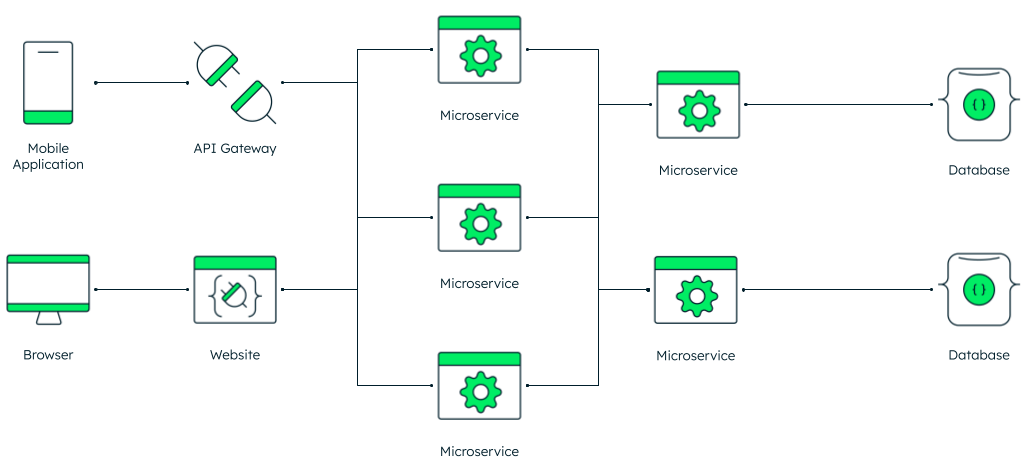As the software development industry continues to evolve, new architecture models have emerged to improve the performance, scalability, and flexibility of modern applications. One of the most popular models today is microservices architecture, a design methodology that breaks down large applications into smaller, independent, and interconnected services.
This blog post will explore the key features, benefits, and challenges of microservices architecture, compare it to the traditional monolithic approach, and provide best practices for implementing it in your software development strategy.
Whether you’re a CTO, business owner, or programmer, this post will equip you with the knowledge and insights to make informed decisions about adopting microservices architecture and help you build software solutions that meet your business requirements.
Contents
I. Microservices Architecture vs. Monolithic Architecture
Regarding software design, there are two primary approaches: monolithic and microservices architecture. Monolithic architecture is a traditional model where all the application components are tightly integrated into a single, large system. Microservices architecture, on the other hand, uses a modular approach where applications are built as sets of smaller, independent, and loosely coupled services.
The key difference between these two architectures is that microservices allow developers to update, maintain, and scale individual services without affecting the rest of the application. At the same time, monoliths require a complete rebuild of the entire application every time a change is made.

Advantages of Microservices Architecture:
- Improved scalability: Since microservices are independent components, it’s easier to scale up or down depending on the workload. You can add more instances of a specific service rather than the entire application, reducing resource waste and improving performance.
- Greater flexibility: With microservices, developers can choose the best technology stacks and programming languages for each individual service. This means that you can use different tools to build different parts of your application, making it more adaptable to change.
- Increased fault tolerance: By using smaller services, you can ensure that if one service fails, it won’t bring down the entire system. Additionally, microservices allow developers to add fault-tolerant measures to specific services, improving overall system uptime.
Disadvantages of Microservices Architecture:
- Increased complexity: With multiple services, it can be challenging to manage and coordinate the interactions between them. Developers can solve this issue by using an API gateway or service mesh to manage communications.
- Higher development costs: Building and maintaining multiple services takes time and resources, which can increase development costs. However, the improved agility and scalability that microservices provide can ultimately lead to cost savings.
II. Key Characteristics of Microservices Architecture
There are several key characteristics that define microservices architecture:
- Numerous components for easy scalability and updates: This allows developers to add, remove, and update components without affecting other parts of the system.
- Resilience through traffic diversion and monitoring: By diverting traffic to health services and monitoring performance, developers can ensure that the system remains resilient and reliable.
- Decentralized operations for greater flexibility: Developers can independently manage and deploy each service, giving greater control and flexibility over the entire system.
- Efficient routing for fast and reliable communication: By using lightweight protocols like HTTP, developers can ensure that communication between services is fast and reliable.
III. Companies Using Microservices Architecture
Several high-profile companies have successfully implemented microservices architecture, including Netflix, Amazon, and Uber. These companies have been able to achieve significant benefits through the use of microservices, including improved scalability, greater flexibility, and faster time-to-market.
For example, Netflix’s microservices architecture has allowed them to scale their application across multiple regions and handle billions of requests per day. Uber has also been able to use microservices to improve scalability and adaptability, allowing them to rapidly expand into new markets around the world.
IV. Best Practices for Microservices Architecture
To make the most of microservices architecture, developers should follow these best practices:
- Analyzing business requirements before implementation: Before building microservices, it’s important to understand your business goals and requirements to ensure that the system is set up for success.
- Adopting secure design with an API gateway: By using an API gateway, developers can create a secure entry point for all services, improving overall system security.
- Using virtual machines for consistent development environments: Since microservices architecture has numerous components, using virtual machines can help developers maintain consistent development environments across different services.
- Separating hosting and deployment for better management: By separating hosting and deployment, developers can quickly roll out updates to individual services without affecting the rest of the system.
- Choosing the right database solutions for microservices architecture: Each service may have its own data storage needs, so choosing the right database solution can help optimize performance and scalability.

V. Challenges and Solutions in Microservices Architecture
While microservices architecture has many benefits, it also comes with its own unique set of challenges. Some common challenges include managing interactions between services, maintaining system performance, and ensuring consistent security measures across all services.
To overcome these challenges, developers should use strategies such as implementing a service mesh, setting up automated monitoring and analysis, and regularly testing system performance and security.
Long in Short:
In today’s fast-paced software development environment, microservices architecture is an increasingly popular choice for organizations looking to build scalable, adaptable, and resilient applications. By breaking down monolithic applications into independent services and using best practices for implementation, companies can reap the rewards of this modern architecture model.
However, embracing microservices architecture also comes with its own set of challenges, which developers must overcome through careful planning, regular maintenance, and constant analysis.
As microservices architecture continues to grow in popularity, companies that adopt this model can enjoy greater agility, flexibility, and performance, allowing them to meet the demands of modern business and stay ahead of the competition.





